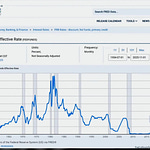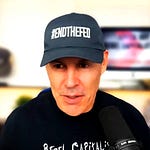“The currency isn’t just paper. It’s the blueprint of the system. Disturb it, and everything else starts to fall.”
If a central bank pauses in the forest and nobody believes them, did they actually do anything?
This is the paradox George Gammon unpacked from a Miami hotel room, riffing on thoughts through a webcam during his recent livestream for Rebel Capitalist Substack subscribers.
The backdrop? The Real Estate Guys' Summit at Sea. The topic? Everything the mainstream financial media missed last week…and a few things they’d rather you didn’t know.
And let’s just say, it didn’t take long for the monetary gloves to come off.
The Hawkish Pause Heard 'Round the World
At the top of the list was the Federal Reserve’s so-called “hawkish pause”…a public relations term so rich in contradiction it would make Orwell blush.
The Fed didn’t lower rates, but instead stated that they are committed to achieving its dual mandate of maximum employment and stable prices, and that the economy is currently in a solid position.
Gammon’s take? "Absolute nonsense."
Let’s not sugarcoat it. The idea that the Fed is the marionette master of interest rates…or the broader economy…is, in Gammon’s words, mythology. Banks lend. Consumers borrow. Markets price. The Fed reacts.
Anyone still clinging to the idea that Jerome Powell controls economic gravity might want to check the expiration date on their Econ 101 textbook.
But here’s where it gets fun: if you were sitting in Powell’s chair, armed with the Fed’s dual mandate of maximum employment and stable prices, what would you do?
Gammon didn’t hesitate. “I’d cut rates,” he said, pointing to a contracting economy, plunging retail sales (down 9.9% in nominal terms), and a labor market that’s “extremely soft.”
Yet, the Fed stood pat. Why? Oil prices. Tariffs. Phantom inflation risks.
Which brings us to a deeper question: Is the Fed fighting yesterday’s battle…or preparing for tomorrow’s war?
Chronically Late, Terminally Wrong
History isn’t kind to the Fed’s timing.
From Greenspan to Bernanke, Yellen to Powell, the pattern repeats: too late to hike, too late to cut, and always catching up to a runaway train they didn’t know was boarding.
Gammon dared viewers to name one instance in which the Fed acted “too early” and unleashed runaway inflation.
Spoiler: they couldn’t.
Even in the run-up to the 2008 Global Financial Crisis, the Fed held tight until the wheels came off…and then scrambled to duct-tape the damage.
And yet, despite weak ISM Services prints, manufacturing contraction, and deteriorating consumer data, the Fed still hesitates. Why?
Because they’re fixated on oil, tariffs, and geopolitics.
But there’s a catch: without wage growth, price increases simply crush demand. No real wage increase, no sustainable inflation.
As Gammon put it, “You’re just robbing Peter to pay Paul.”
And speaking of paying people…something strange just happened with the dollar.
The Dollar’s April Nose-Dive: A Curveball from the BLS
Buried in a report from the Bureau of Labor Statistics was an unexpected explanation for April’s sharp drop in the U.S. dollar.
No, it wasn’t foreign dumping of Treasuries.
It wasn’t anti-Trump retaliation or deficit panic.
It was… wait for it…
Listen to this episode with a 7-day free trial
Subscribe to Rebel Capitalist News Desk to listen to this post and get 7 days of free access to the full post archives.












